CHASING THE INDRI
Journey To Beauty & Chaos In Paradise Islands
Madagascar: Erotic Tombs, Tribal Warriors & Bull Fights In The Great Red Island
Part
II
Tan Wee Cheng, Singapore (July 2003)
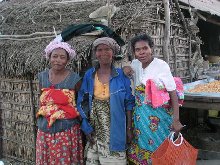 |
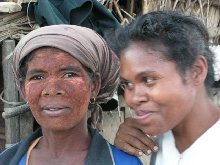 |
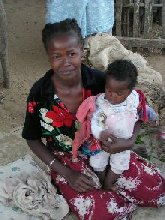 |
|
| Scenes of Toliara (Tulear) | |||
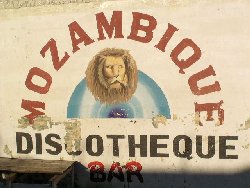 |
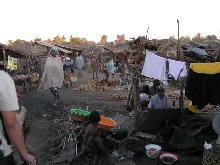 |
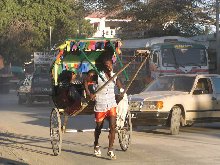 |
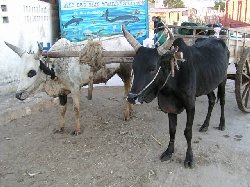 |

Journey To Beauty & Chaos In Paradise Islands
Madagascar: Erotic Tombs, Tribal Warriors & Bull Fights In The Great Red Island
Part
II
 |
 |
 |
|
| Scenes of Toliara (Tulear) | |||
 |
 |
 |
 |
We
flew south to Toliara, the provincial capital in the poorest and least inhabited
part of the country. This is a dry
semi-desert land of spiny forests and low shrubs on the southern coast of
Madagascar. The tribes of this
region, the Vezo and Mahafaly, are among the most “African” of the Malagasy
tribes. Tall and shining dark in
complexion, they hardly display any of the Asian features common among the
Merina people of the Highlands around Tana.
The Mahafaly is also famous for their impressive tombs. These tombs tend to be mini buildings painted with bright colours, featuring scenes from the lives of those buried within. I have seen themes ranging from traditional ones such as zebu fights – zebus are the omnipresent Malagasy bull which has a distinctive hump on its back - and country life, to contemporary ones featuring space shutters and aircraft, plus one with Leonardo diCaprio and Kate Winslet together, inscribed “Titanic”. Many tombs also have zebu horns on them symbolising power, and some have stelae and poles with elaborate carvings, some of which are erotic in nature. All this contrast deeply with the state of abject poverty in this region, where many live in huts made of leaves and tree branches, the only mitigating factor of which is that the region is mostly hot during the day although temperature drops drastically in the evenings. Is the after life more important than the present?
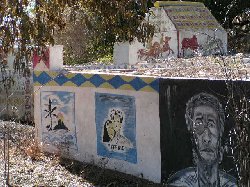 |
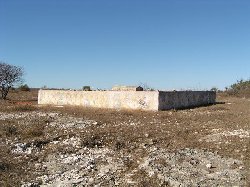 |
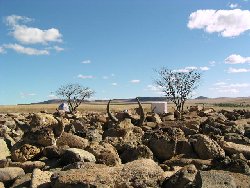 |
|
|
Tombs of Madagascar |
Zebu horns on a tomb | ||
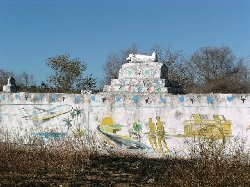 |
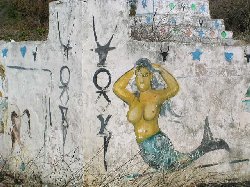 |
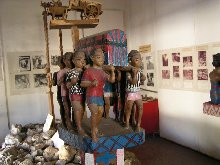 |
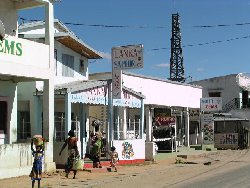 |
| Saphire town - Sakaraha | |||
The
Malagasy people are famous for their veneration of the dead.
The Highland tribes practise a ceremony known as famadihana – turning
of the bones, which is an occasion for rejoicing rather than mourning.
Periodically, the dead were exhumed, washed and rewrapped in new shrouds.
Relatives visit the dead, and celebrated his life with lots of pomp and
ceremony, and drinking and feasting, after which the dead is returned to his
grave accompanied with many gifts.
This
is also lobster country. We saw the
largest lobsters of our lives in the local market, bought some for a song and
got someone to cook for us. The
pleasures of life!
----
Madagascar
is a big country with awful roads and poor public transport.
Route Nationale 7 (RN 7), which stretches from Tana (in the middle of the
country) to the south disappears into mud and sand in some areas.
The most common form of public transport is the taxi-brousse, or bush
taxi, which can be any type of vehicle, usually with luggage tied to the top,
and human capacity squeezed to the maximum, together with assorted chickens,
ducks and furniture that accompany the passengers.
Our original plan is to take taxi-brousse from south to north but given
that taxi-brousse takes a long time to reach anywhere and that they do not
depart on regular hours, we have to seek more costly alternatives to do RN7 in
the short timescale that we have.
Therefore, whilst in Tana, we arranged for a chauffeured car to bring us from Toliara back to Tana over a period of 8 days, stopping by in various cities and national parks in between. Tobi, the designated driver, was unable to make it in time and so a taxi was arranged to pick us up in Toliara and drive us through to Isalo National Park where Tobi would be waiting for us.
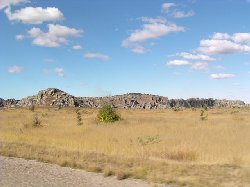 |
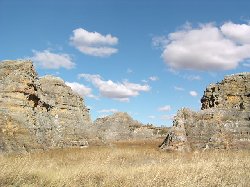 |
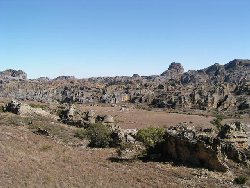 |
|
| Isalo National Park | |||
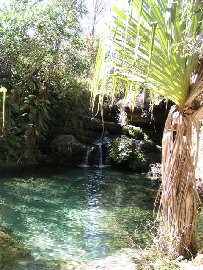 |
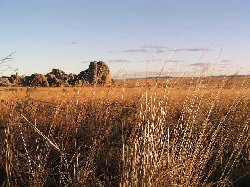 |
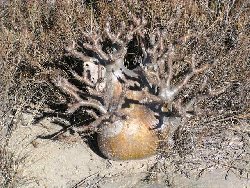 |
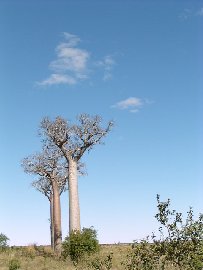 |
And
so off we went northwards along RN7. It’s
a dry, dry road passing through miserably poor hamlets with surprisingly
cheerful people. Despite their
poverty, we found the Malagasy people most hospitable and friendly. They also love to be photographed. Everywhere, the locals urged us to take their photos, and no
payment was ever asked. This must
be a paradise for those who love portrait shots in exotic locations.
We
also passed a few baobab trees. The
baobab is a magnificent tree with a straight, thick bulging stem, and quite
often with branches concentrated at the very top.
In Madagascar where rainfall is scarcer than continental Africa, baobab
branches sometimes look disproportionately small compared to their tall thick
trunk. In Africa, the baobab tree
exerts an aura that is legendary. The
baobab is large and often lives for a long time, as it is often too large to be
chopped down. As such, it is often
a meeting place and local landmark, not only for humans but animals as well.
Its trunk stores water and provides clean drinking relief for travellers
in the desert. Village elders tell
tales beside it and the animals rest by it.
It is the source of goodness and wisdom in African folklore, and surreal
and photogenic for the traveller.
Before
we reached Isalo National Park, we passed two sapphire towns, Sakaraha and
Ilakaka. This is the local
equivalent of the Wild West, settlements that spurted out overnight with the
discovery of sapphire. For a region
renowned for its poverty, these were islands of bustling shops, restaurants,
bars, casinos, inns and vices of every kind – women in bright dress and overly
heavy makeup seemed to be in great supply here compared to Toliara. We did not stay for long in these dodgy places as we stick
out like sore thumb. Drunken miners
and working gals stared at us, while police subject our taxi drivers to long
chats (and bribe demands) at every checkpoint on that stretch of RN7.
Many
people thought we were Thai. Many
Thai come here to buy sapphires. They
have even set up their own hotel for collective security and familiarity,
complete with neon lights and a sign that reads “Casino”.
We saw a smartly dressed Thai trader in his chauffeured car at a police
check point. He passed a thick
bundle of banknotes to the police and drove past the checkpoint in no time,
whereas we had to spend many minutes for him to examine our documents and
extract a few extra franc from our driver.
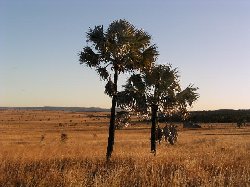 |
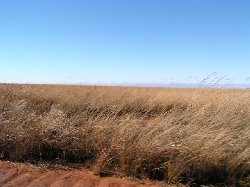 |
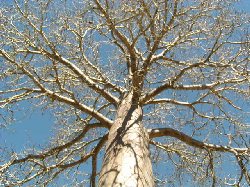 |
|
| African Dawn | Travellers Palms At Isalo N.P. | The Plains of The South | Magical Baobab |
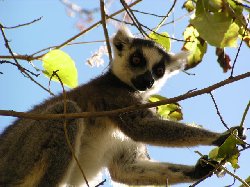 |
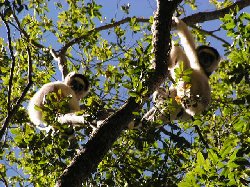 |
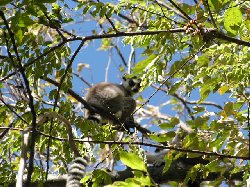 |
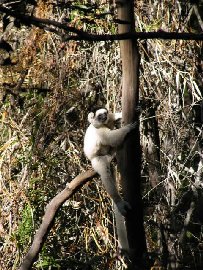 |
| Lemurs | |||
At
Isalo, we met our driver Tobi, a nice forty-plus who knows what the traveller
wants. He has a pair of sharp eyes
and was able to spot village celebrations and feasts two hundred meters away.
And he would drive up muddy tracks so that the traveller is given an
exotic visual and emotional feast into Madagascar’s colourful village life and
culture. He is the man I would
recommend for any journey through the Great Red Island.
Those of you who know how thrifty I am would be pleased to know that I
have tipped him well to the tune of a decent proportion of the country’s per
capita GDP.
We
also met Rainer, a cheerful German finance controller who squeezed a Malagasy
cycling trip between work in South Africa and a business trip to China. We had many discussions on the world of adventure travel,
business and finance. We did a few
treks together in this national park, the Malagasy answer to the Grand Canyon,
and punctuated our complaints of mud and deforestation with discussion about the
troubles of the global auto industry and effective hedging strategy.
Madagascar
is renowned for its wildlife, not so much for its abundance, but rather, its
uniqueness and the fact that its many rare endemic species now come under
unprecedented threat from deforestation and human population growth. The lemur is Madagascar’s chief mascot and the poster boy.
The lemur is a cute, monkey-like creature often with long tails and
rather slow reflex. They are the
ancestors of all apes, including man, and the missing link in the chain of
evolution. Their slowness and
sleepiness rendered them uncompetitive in the food chain, and had long gone
extinct in the African Mainland and elsewhere.
In Madagascar, however, in the absence of other primates (such as
monkeys), large predators and until 2000 years ago, humans, the lemurs have
survived and evolved separately. The
lemurs are now under threat – the giant lemur and other species have long
disappeared. Fourteen species
remain and these cute creatures have lured many tourists to this country, in the
hope of seeing them before they disappear for good.
We
walked around the national park in search of lemurs.
We have been warned that deforestation and poaching have become so
serious that tourists often have to go to the zoo in Tana at the end of the trip
to see some serious lemurs. We were
lucky – we saw three species at Isalo and would see a few more species for the
rest of the journey in other national parks.
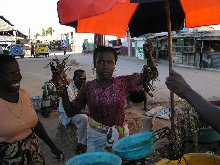 |
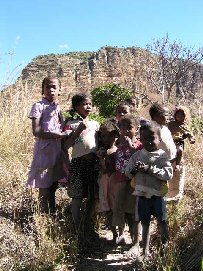 |
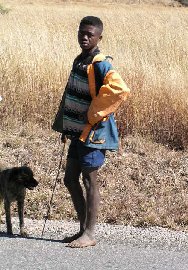 |
|
| Baobab | Lobsters! | Friendly Locals | |
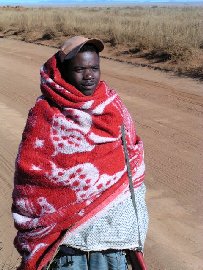 |
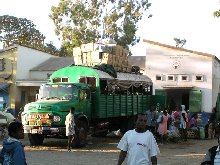 |
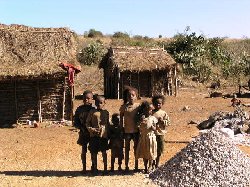 |
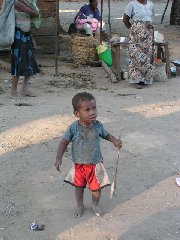 |
| Bara Warrior & His Rifle | Bush Taxi | ||
We sped eastwards from here, heading for the Highlands. We entered the country of the Bara, a fierce warrior tribe who value their zebu more highly than anything else. Tradition has it that every young Bara has to prove his manhood by stealing a few zebus, and only then will he prove his worth among Bara girls. The zebu symbolises wealth and power to the Malagasy people, and this is even more the case for the Bara. All major ceremonies are accompanied by the sacrifice of zebus. That’s why the Bara guard their zebus with their lives. We passed a few zebu herds with their masters on these dry savannah plains. We stopped by a young fierce-looking warrior armed with an ancient rifle and a red Chinese woollen blanket wrapped tightly around his torso – they used to be dressed in zebu skin but this Chinese factory-manufactured stuff is cheaper and better in fighting cold. We asked one how many zebus he owned. “Three hundred,” said the proud warrior with a faint smile, and asked for some cookies as a present.
![]() Madagascar
Madagascar
![]() Send
your comments to Tan Wee Cheng, Singapore
Send
your comments to Tan Wee Cheng, Singapore
![]() Back to Homepage of CHASING THE INDRI
Back to Homepage of CHASING THE INDRI
![]() Back to the Main Homepage of Weecheng.com
Back to the Main Homepage of Weecheng.com